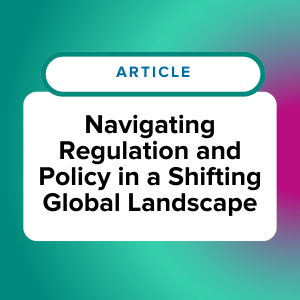Prioritizing Food Innovation: Navigating Regulation and Policy in a Shifting Global Landscape

As innovation in food technology accelerates, the regulatory frameworks meant to guide safety, sustainability, and market access are evolving in parallel—but not always at the same pace.
From cultivated meat approvals to scrutiny around ultra-processed foods and colorants, global food-tech policy is undergoing profound transformation. For food-tech leaders, success hinges on a deep understanding of regulatory nuance and the agility to navigate shifting landscapes. This evolving landscape will be a central topic at Future Food-Tech Chicago on June 2-3, where industry leaders including Lars Langhout (NoPalm Ingredients), Megumi Avigail Yoshitomi (Japan Association for Cellular Agriculture), Hannah Lester (Atova Regulatory Consulting), and Nadav Berger (Peakbridge) will share their insights. Summit delegates can hear from these experts directly as they explore how businesses are adapting to global regulatory shifts in real time. Read on for a preview before they take the stage in Chicago.Regulatory Breakthroughs Are Setting a New Global Pace
Recent global developments in novel food approvals are signaling a new era for food innovation.
The FDA’s greenlight for Mission Barns’ cultivated pork fat follows earlier approvals for UPSIDE Foods and GOOD Meat—clear signs that the U.S. regulatory system is warming to cell-based products. However, this federal progress comes amid growing regulatory divergence at the state level, with several U.S. states moving to ban the sale of cultivated meat.These conflicting signals highlight the complex—and at times fragmented—regulatory environment that innovators must navigate. Lars Langhout, CEO of NoPalm Ingredients, views the federal momentum as a long-awaited alignment between scientific progress and regulatory acceptance.
In the Asia-Pacific region, regulators are increasingly assertive. Nadav Berger, Founding General Partner at Peakbridge, highlights the recent regulatory pre-approval of Vow’s cultured quail cells in Australia and New Zealand as a standout moment. “Vow is leading the charge in their sector, with industrial capacity and products already sold in some two dozen restaurants in Singapore,” he says. “It’s good to see select countries taking a stance to be leaders in the space.” Megumi Avigail Yoshitomi echoes this enthusiasm, pointing to Vow’s cultivated quail launch in Hong Kong as a breakthrough with regional ripple effects, potentially accelerating activity in markets like China and Japan. She notes that this "China factor" could “potentially prompt other countries to advance their own regulatory frameworks.”
Meanwhile, in Europe, the EFSA’s restructuring of its Novel Foods Working Group into product-specific subgroups indicates a more adaptive approach to managing the increasing diversity of applications. In the UK, the Food Standards Agency’s new sandbox program—piloting the assessment of cultivated food safety—is another key development. Hannah Lester of Atova Regulatory Consulting calls it “an important leap forward” that signals openness to novel food pathways. The recently launched Innovation Hub is designed to expand regulatory capacity in emerging areas such as precision fermentation. The hub aims to provide greater clarity to innovators and investors, while ensuring consumer safety. Thomas Vincent, the Deputy Director of Innovation for FSA, will present more on this initiative at Future Food-Tech Chicago, offering a deeper look at how the UK is aligning safety and innovation to build a pro-innovation regulatory system.
Leveraging Policy Shifts While Managing Uncertainty
As the U.S. regulatory climate becomes more focused on health, especially regarding ultra-processed foods (UPFs), food-tech innovators must be more vigilant than ever.
Hannah Lester notes that the main agenda under RFK Junior’s FDA is “targeting ultra-processed foods” through its Nutrition Regulatory Science Program, exploring how additives and ingredient processes affect human health. She warns that even highly innovative companies are not immune—referencing lawsuits against players like Perfect Day as cautionary examples. To adapt, forward-thinking companies are embedding regulatory foresight into product design. Langhout advocates for designing around sustainability and compliance from the start—not as a marketing add-on, but as a foundational strategy: "Sustainability should not just be a claim—it must shape the innovation itself", he says. This includes localizing production, enhancing transparency, and fostering early dialogue with regulators. Yoshitomi recommends that companies consider regulatory-friendly geographies like Singapore, Australia, South Korea, and the UK, which offer clearer paths to commercialization compared to the increasingly complex U.S. environment. Japan, she notes, is expected to provide long-awaited regulatory clarity later this year.
)
)
)
)
)
)
)
)
)
)